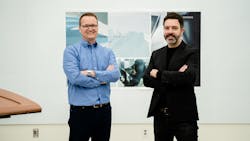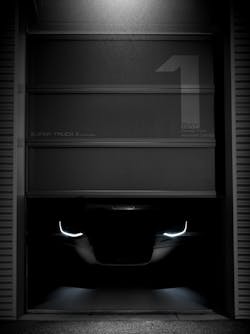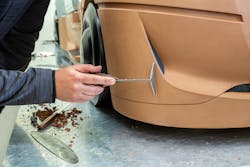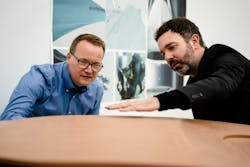How DTNA created the SuperTruck with the customer in mind
Daimler Truck North America (DTNA) has been designing and developing its efficient and sleek prototype and research truck, SuperTruck II, which according to the OEM, requires collaboration and creativity to prepare for its 2022 launch.
Launched in 2016, SuperTruck II is the Energy Department’s second investment in next-generation technologies, with a focus on cost-effective solutions to more than double freight efficiency in trucking. SuperTruck II is a DTNA research and development program co-funded by the U.S. Department of Energy to develop a tractor-trailer combination using a suite of technologies including active aerodynamics, advanced engine combustion with enhanced air handling and intercooling and hybridization.
It is DTNA’s second time participating in a SuperTruck initiative, allowing the manufacturer to investigate high-risk, high-reward technologies to clear the technical pathway for their development and potential integration in series production. According to DTNA, the goal is to develop commercially viable solutions that benefit the customer. Particularly, within the transformation from clean diesel combustion engines to battery-electric transportation, DTNA sees potential to improve energy efficiency even further.
Designing the SuperTruck
With the parameters set, DTNA’s engineering and design teams began the initial investigation of how to combine efficient technology with sleek, aerodynamic design. To start such a big undertaking, the design team began looking at nature such as form inspiration—like the way wind carves out snowdrifts and sand dunes—to create beautiful sculptural shapes with sharp edges. The designers leveraged the SuperTruck project to help define this new aero form language for the Freightliner brand.
“We see SuperTruck in a different way than other projects,” said Jeff Cotner, chief designer at DTNA. “It allows us to take risks…we feel very much that this is our opportunity to push a little bit and reach further out than we otherwise would. Normally, we might not have the time or resources to support investigating something that is not necessarily doable. So for SuperTruck, we get to experiment.” An experiment with the needs of the customer in mind.
The Design Center Studio at DTNA—based in Portland, Oregon— is a key area where ideas and concepts start to become reality. With designers, surface modelers, fabricators and studio engineers, the design team collaborates globally to create the most cutting-edge designs that continue to push DTNA’s products forward. The design team also welcomed a bit of competition for the overall design. Multiple designers begin sketching initial concepts and a friendly competition ensued.
“Something really amazing happens in that process because as a designer comes up with really cool and interesting ideas, it inherently inspires the other designers,” said Cotner. “There is this organic evolution, and inspiration, and excitement that comes from the competition.”
Engineering the SuperTruck
The engineering team, however, had more stringent parameters to adhere to. Comprised of a select group of creative engineers, the advanced engineering team supports and works with the entire DTNA organization.
With the initial SuperTruck project, the team was able to focus more on fundamental research and development, ultimately finding success with improved freight efficiency by 115%. For SuperTruck II, the team based concepts off technologies that are likely to hit the market in a few years. The project is on track to achieve even more ambitious efficiency goals.
See also: DOE to put $80 million into ultra-efficient heavy truck project
“These objectives were to develop technologies that are commercially cost-effective in terms of a payback in the next couple of years,” said Darek Villeneuve, advanced vehicle systems manager at DTNA. “The most difficult part is picking the right technologies with the right balance of performance for systems that are critical for energy conservation while making them complement the vehicle.”
Two departments band together
As engineering worked to perfect their technology, the design studio kept close tabs on their work. Ultimately, even with the coolest design, the design team understood their work would not matter unless it helped engineering reach their goals and ultimately improve customers’ efficiency targets. A constant flow of communication helped the designers focus on the most important parts of the truck for aerodynamics and energy efficiency. As Villeneuve noted, technology cannot be developed in a vacuum and requires strong partners, both internal and external.
“We understand that the design studio needs to be given freedom to explore. There was a lot of give and take throughout the whole process, along with challenging each other to figure out what’s really critical,” Villeneuve said. “I think the product will speak for itself that it’s a fantastic looking vehicle and the performance is the best we’ve ever produced.”
Always at the forefront of everyone’s mind was the importance of keeping true to Freightliner’s brand values and push to make transport efficiency priority number one. Freightliner, an industry-leading brand in North America, is well recognized for its innovative technologies and efficiency since its beginning in 1942. A number of innovative features from DTNA’s first SuperTruck are available today in the Freightliner Cascadia, including enhanced aerodynamics, improved engine thermal efficiency and powertrain integration technologies such as down speeding, and predictive powertrain controls.
“We want SuperTruck II to stand out and be seen. Something transport company owners and drivers will get excited about,” said Cotner.
About the Author
FleetOwner Staff
Our Editorial Team
Kevin Jones, Editorial Director, Commercial Vehicle Group
Josh Fisher, Editor-in-Chief
Jade Brasher, Senior Editor
Jeremy Wolfe, Editor
Jenna Hume, Digital Editor
Eric Van Egeren, Art Director



